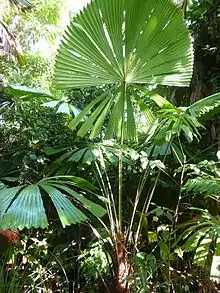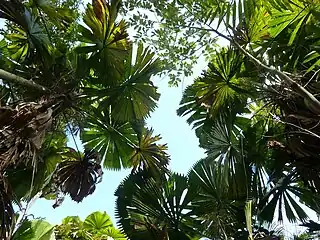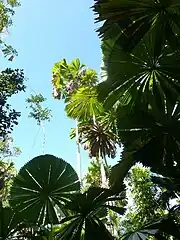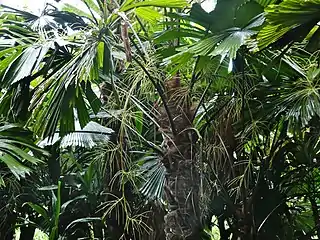| Licuala ramsayi | |
|---|---|
 | |
| Licuala ramsayi near Mission Beach, Queensland | |
| Scientific classification | |
| Kingdom: | Plantae |
| Clade: | Tracheophytes |
| Clade: | Angiosperms |
| Clade: | Monocots |
| Clade: | Commelinids |
| Order: | Arecales |
| Family: | Arecaceae |
| Tribe: | Trachycarpeae |
| Genus: | Licuala |
| Species: | L. ramsayi |
| Binomial name | |
| Licuala ramsayi | |
Licuala ramsayi, commonly known as the Queensland fan palm or Australian fan palm, is a species of tree in the palm family Arecaceae which is endemic to northeastern Queensland, Australia. Two varieties are recognised: Licuala ramsayi var. ramsayi,[1] and Licuala ramsayi var. tuckeri.[2] It is the only species of the genus Licuala present in Australia.
Description
L. ramsayi is a distinctive palm with a single trunk to 16 m (52 ft) tall and 20 cm (7.9 in) diameter.[3] It has large, pleated, circular leaves up to 2 m (6 ft 7 in) in diameter. Petioles have formidable spines to 5 mm (0.20 in) long. The fruits are a red drupe around 10 mm (0.39 in) diameter containing a single seed.[4]
Distribution and habitat
The species grows in swamps, along riverbanks, and in rainforests in Australia. In favourable conditions it may dominate small areas, forming a "fan palm forest".[5] L. ramsayi var. tuckeri is found in Cape York Peninsula southwards to about Cooktown,[2] while L. ramsayi var. ramsayi occurs from Cooktown to the Paluma Range north of Townsville.[1]
Ecology
Trees provided an edible cabbage to Aboriginals, as well as thatch, food wrapping, and cigarette papers (from young leaves)[5] Fruits are eaten by cassowaries.[4]
Gallery
 Licuala Walking Track near Wongaling Beach, Queensland
Licuala Walking Track near Wongaling Beach, Queensland
 The spidery inflorescence
The spidery inflorescence_004.jpg.webp) Dominating a section of rainforest
Dominating a section of rainforest
References
- 1 2 F.A.Zich; B.P.M.Hyland; T.Whiffen; R.A.Kerrigan (2020). "Licuala ramsayi var. ramsayi". Australian Tropical Rainforest Plants Edition 8 (RFK8). Centre for Australian National Biodiversity Research (CANBR), Australian Government. Retrieved 20 June 2021.
- 1 2 F.A.Zich; B.P.M.Hyland; T.Whiffen; R.A.Kerrigan (2020). "Licuala ramsayi var. tuckeri". Australian Tropical Rainforest Plants Edition 8 (RFK8). Centre for Australian National Biodiversity Research (CANBR), Australian Government. Retrieved 20 June 2021.
- ↑ Dowe, J.L.; Jones, D.L. (2022). "Licuala ramsayi". Flora of Australia. Australian Biological Resources Study, Department of Climate Change, Energy, the Environment and Water: Canberra. Retrieved 14 October 2023.
- 1 2 Cooper, Wendy; Cooper, William T. (June 2004). Fruits of the Australian Tropical Rainforest. Clifton Hill, Victoria, Australia: Nokomis Editions. p. 71. ISBN 9780958174213. Retrieved 20 June 2021.
- 1 2 Beasley, John (2009). Plants of Cape York - the compact guide. John Beasley. p. 144. ISBN 978-0-9806863-0-2.
External links
 Data related to Licuala ramsayi at Wikispecies
Data related to Licuala ramsayi at Wikispecies Media related to Licuala ramsayi at Wikimedia Commons
Media related to Licuala ramsayi at Wikimedia Commons- Palm and Cycad Society of Australia